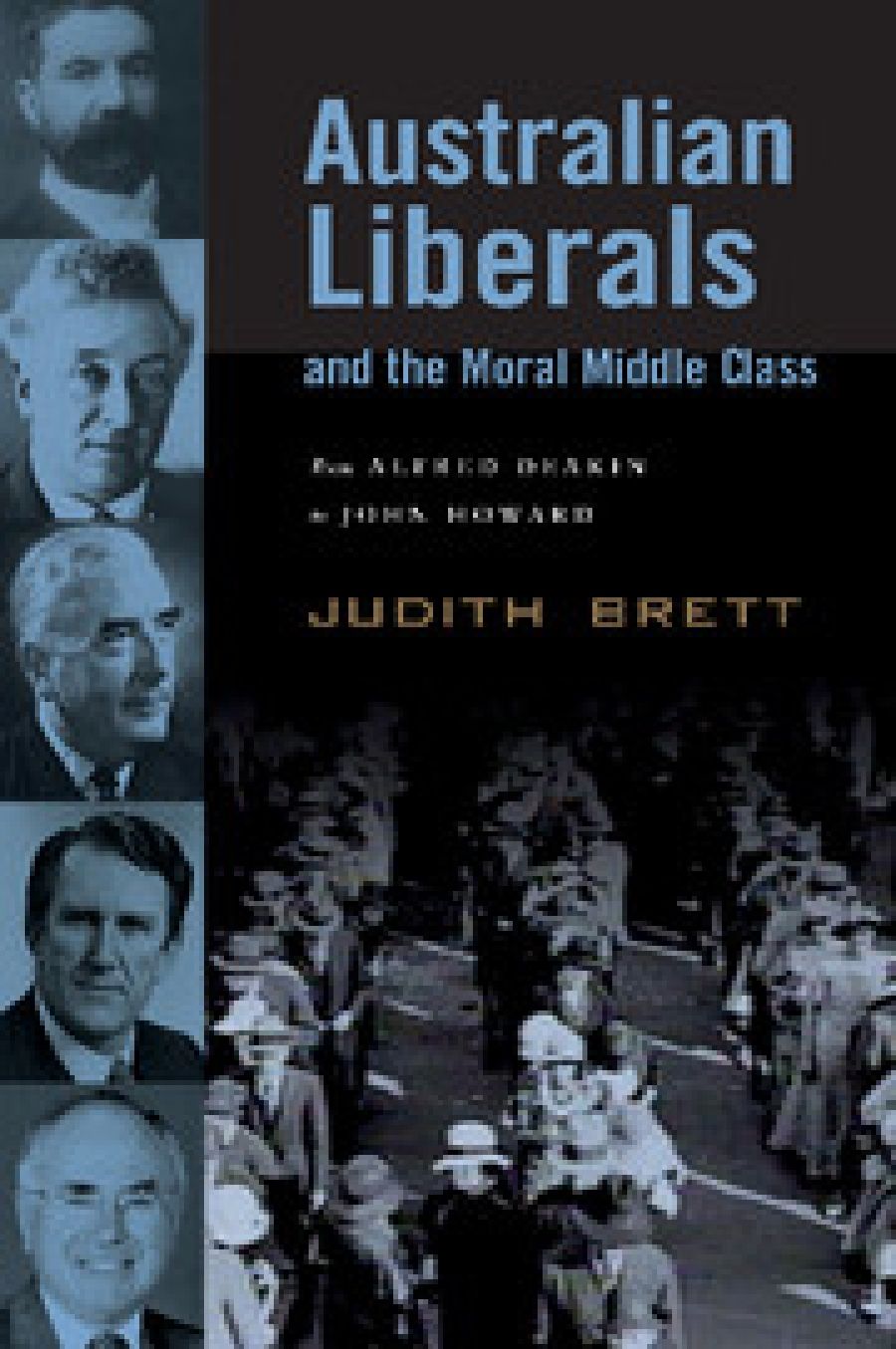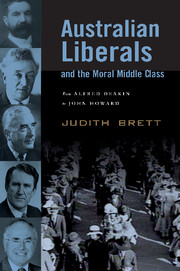
- Free Article: No
- Contents Category: Politics
- Review Article: Yes
- Article Title: Liberal Tides
- Online Only: No
- Custom Highlight Text:
This book is dedicated to Judith Brett’s grandparents, ‘none of whom ever voted Labor’, and their grandchildren, ‘most of whom do’; and concludes with the observation that ‘the relationship between … emerging social formations and nationally based political parties is not yet clear – or at least not to me’. The dedication suggests even-handedness, and the concluding words imply a commitment to evidence as the basis for argument. These qualities characterise this major study of Australian Liberalism – an impressive personal achievement and a significant event in Australian intellectual life – though Brett sometimes appears to believe that they are one and the same thing, and that, in order to understand human relations, one must first accept the equal validity of ideologically opposed views.
- Book 1 Title: Australian Liberals and the Moral Middle Class
- Book 1 Subtitle: From Alfred Deakin to John Howard
- Book 1 Biblio: Cambridge University Press, $37.95pb, 271pp
- Book 1 Cover Small (400 x 600):

- Book 1 Cover (800 x 1200):

Brett’s primary aim is to extend her and our understanding of the cultural bases of past and present Liberal Party policy, a project she began in her earlier work, Menzies’ Forgotten People (1992): ‘This book is a sequel. It goes back to Deakin, Bruce and Lyons to explore the origins of Menzies’ mid-century construction of the political world, and forward to Fraser and Howard to see what became of it.’ She takes as her primary material ‘the words of those [leaders and intellectuals] who subscribed’ to the Liberal tradition, and finds deep connections between these statements and strains of Australian culture, particularly Protestantism. Perhaps not surprisingly, given the focus on cultural sources of thought and behaviour, Brett’s main argument is that previous histories have paid insufficient attention to this evidence, to the self-understandings of Australian Liberal politicians, supporters and voters, and have overemphasised the impact of socio-economic or class factors. It is Liberalism, Brett writes:
albeit broadly understood and with many internal contradictions, that has provided much of the basis for the party’s enduring electoral appeal … people have voted for the party not just because it has represented their interests but because it has accorded with what they believed. This is an argument which flies in the face of the class-based model which has dominated interpretations of the Australian party system.
Throughout, Brett emphasises the agency of middle- and working-class Liberal voters and the positive, active reasons for their voting choice, in contrast to class-based interpretations that point to the party’s persistent inducement of, and capitalisation on, ignorance, prejudice and fear.
In the immediate aftermath of Federation, at a time when Labor and Liberal Protectionist parties ‘seemed the natural alliance’ and had more in common in terms of policy than the Liberals and the free trade anti-socialists, the Liberals ultimately chose to join with the free traders, not because, as middle-class parties, they had common economic interests, but because they could not reconcile themselves to the nature of the Labor Party’s organisation. For the Liberals, Labor’s demand that members ‘pledge’ to follow the will of the party, would have constituted relinquishment of their conscience, that which they believed made them free men.
Against the received wisdom that Australian Catholics joined Labor for class reasons, Brett argues that Catholics were under-represented in the Liberal Party and its antecedents primarily because they were made to feel unwelcome by the overwhelmingly Protestant Liberals.
Importantly, Liberals believed that each person’s primary political responsibility should be to the society as a whole, not to any sectional interest: ‘Liberals conceptualised people’s political being first and foremost as citizens … a direct challenge to Labor’s appeal to people’s class consciousness.’ Liberals also attached particular moral importance to personal saving and to the capacity to pay one’s way:
For Australians, the commonsense precepts of sound finance were not simply about the projection of certain vices on to the working classes; they were also about the affirmation of middle-class virtues in which the way one handled one’s money was as much a moral as a financial matter.
Again, Brett concludes that class interests were secondary to liberal beliefs ingrained by a common imagination and middle-class experience. Where historians have commonly seen the working class undergoing ‘embourgeoisment’ during the increasingly affluent post-World War II ‘long boom’, Brett contends that the rise in home ownership, consumer credit and white-collar employment represent the realisation of an already dominant Liberal dream. She suggests, though, that the declining social relevance of Protestantism, living within one’s means and active citizenship significantly disrupted Liberal culture.
At the collapse of the postwar Keynesian consensus, the dismissal of Whitlam and the appearance of Fraser, the thrust of Brett’s historical narrative shifts from asserting the relative importance of cultural, as opposed to class, factors in the behaviour of Liberal politicians, organisers and voters to asserting the arrival of a new era of globalisation, characterised by ‘the end of certainty’, in Paul Kelly’s influential phrase, and by the virtual end of class as a popular basis for personal identity and a useful tool of social analysis.
The study is based on a great deal of original evidence and is a pleasure to read; key concepts and historical narrative are seamlessly interwoven. But, as mentioned, there are conceptual problems. While Brett’s identification of the cultural sources of traditional Liberal belief is illuminating, the trouble with focusing on and taking at face value Liberal statements is that unconscious or deliberately obfuscatory elements of these statements cannot then be taken into account. In their attitudes to fusion (with the free trade anti-socialists), sectional interests and the moral imperative of saving, Liberal leaders and their predominantly middle-class supporters may have believed themselves to be acting out of deeply held moral convictions, but this does not in itself prove that they were not also acting out of often unacknowledged class interests, any more than nineteenth-century British soldiers’ and missionaries’ belief that they were spreading civilisation disproves a critique of imperialism. If Deakin’s Liberals were so unwilling to be morally compromised, why did they side with their erstwhile enemies, the free trade anti-socialists, rather than maintain their independence? Obviously, the price of such independence, electoral failure, was for class reasons deemed too high. It is quite possible that both class-based and culturalist interpretations might be simultaneously valid at any point in time.
Similarly, Brett’s unwillingness to consider the possibility of John Howard’s fundamental dishonesty leads to a reading of his present deployment of anti-élite and ‘vernacular egalitarian’ class rhetoric as symptomatic of the free-floating nature of contemporary political parties and loyalties, rather than as evidence of the continuing appeal of class politics within an historical moment when the obvious avenues for these alternatives have been all but crushed by bilateral support for neo-Liberalism. As Brett notes, only one per cent of today’s parliamentarians were, before entering parliament, ordinary wage-earners, people who might fit a traditional definition of ‘working class’. This fact may, when considered alongside the obvious economic interests of other institutions and organisations that have supported this neo-Liberalism against the wishes of the majority, help to explain its present dominance. Some ten years ago, Brett argued that Liberals faced long-term structural problems in their fight to survive, since Labor had institutionalised a cultural reality in which people no longer related to the state as individuals. Now it seems something like the opposite view is being put forward. Perhaps this desire to make predictions about the future, characteristic of intellectuals associated with Arena magazine, has led Brett to overemphasise the cultural dominance of contemporary Liberalism.
Despite these reservations, Brett’s study must be recognised as a valuable contribution to public and scholarly understandings of Australian history and society.


Comments powered by CComment